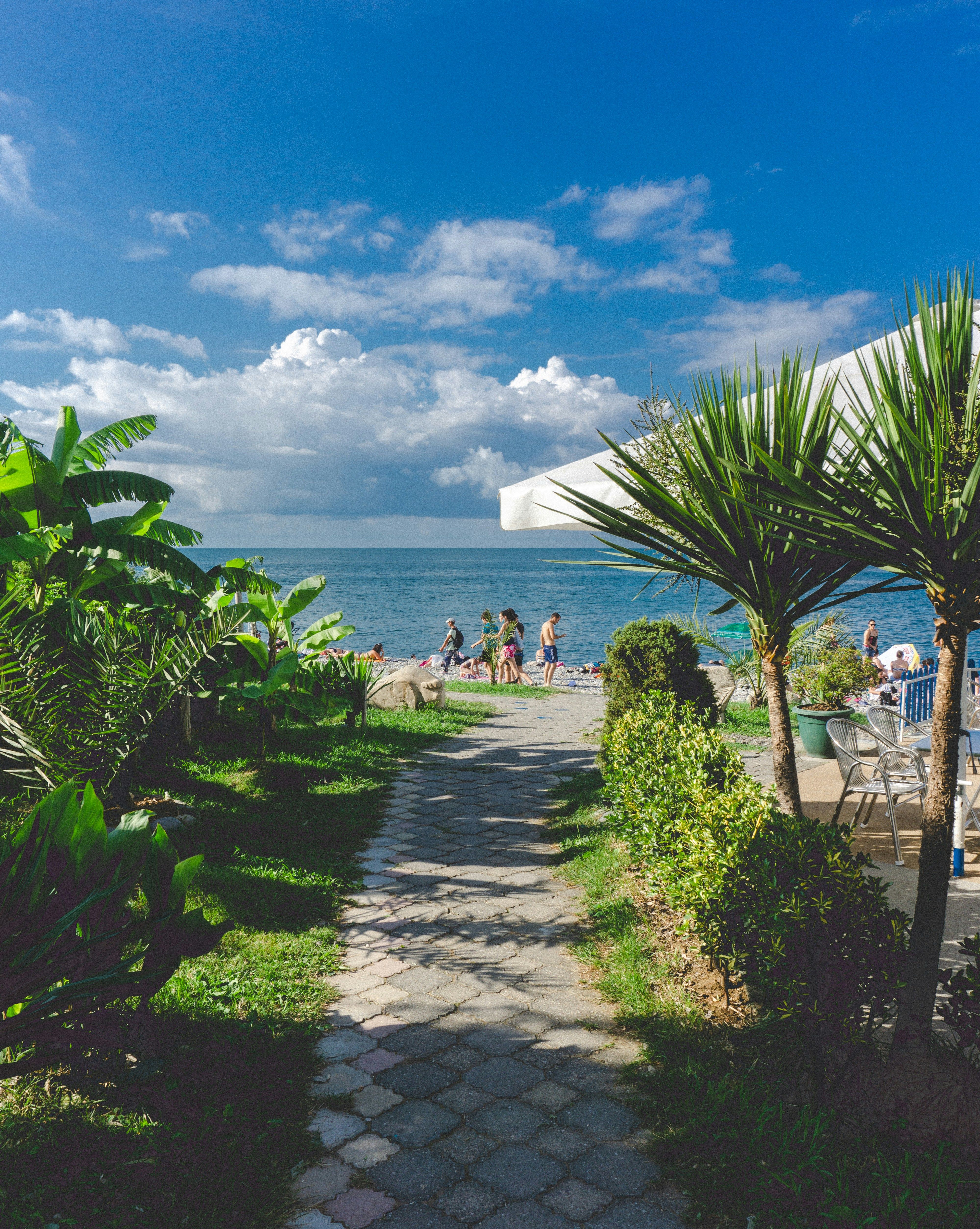Cultivating Bougainvillea: A Comprehensive Guide
Bougainvillea: A Vibrant and Colorful Evergreen for Home and Garden
Bougainvillea, a showy and dramatically colored evergreen, is an excellent addition to any home, conservatory, or greenhouse. Its 'flowers,' which appear in a vast array of colors, such as purple, mauve, pink, apricot, red, yellow, and white, are actually the large, paper-thin bracts that encircle a small cluster of white, inconspicuous flowers.
Originating from Brazil, this plant has since become widely popular as a garden feature in diverse regions like the Mediterranean and California. Named after the 18th-century French exploreer, Comte de Bougainville, it can commonly be seen scrambling up fences, over pergolas, forming hedge-like boundaries, and adorning villa walls in hot countries.
The Bougainvillea flourishes under frost-free conditions and, thus, should only be cultivated outdoors during summer in the UK. This plant can produce sustained flushes of bloom for several months if the conditions are right. In the UK, bougainvilleas are often sold as houseplants, kept within a hoop of wire or a frame, but they can also be grown as bushes, up walls, or over arches, providing they have ample space for growth. Compact varieties that reach about 1m in height are also available, making them suitable for smaller spaces or even hanging baskets.
Table of Contents
- Planting Bougainvillea
- Caring for Bougainvillea
- Pruning and Training Bougainvillea
- Propagating Bougainvillea
- Pests and Problem-Solving
- Where to Buy Bougainvillea
- Best Bougainvilleas to Grow
Where to Grow Bougainvillea
Bougainvillea requires full sun and can be grown in a frost-free location by a window, in a conservatory, or heated greenhouse. It can tolerate temperatures as low as 2°C, but an ideal winter temperature during winter is 7-10°C. At temperatures below 10°C but above freezing, bougainvilleas may lose some or all of their leaves, but growth will resume as temperatures increase. Those in pots can be moved to spend summer outdoors in a sunny, sheltered spot before moving them back indoors for winter. Think carefully about placement due to its thorny stems.
When to Plant Bougainvillea
The ideal time to plant bougainvillea is in spring or early summer when the weather is warmer. This gives the plant opportunity to establish itself before the colder months arrive.
How to Plant Bougainvillea
Bougainvillea plants are commonly sold in small pots. Repot them into a larger pot (around 25-30cm in diameter) as soon as possible. Soak the roots in water for an hour before removing them from the old pot and planting them in the new container. Use a high-quality, peat-free multi-purpose potting compost. Fill the container about halfway, placing the plant so the top of the compost is a couple of centimeters below the rim of the new pot. Carefully fill in the compost around the roots and water thoroughly. When growing bougainvillea in a greenhouse border, first dig in well-rotted compost or organic matter before planting, keeping the root ball level with the surrounding soil.
How to Care for Bougainvillea
Proper watering and feeding are vital in caring for a bougainvillea:
- During spring, increase the frequency of watering to twice or three times a week, depending on outside temperatures. Avoid over-watering, as bougainvilleas suffer if their roots are waterlogged.
- Start feeding bougainvilleas once a week from mid-spring until mid-autumn. A high nitrogen fertilizer promotes leafy growth, while a fertilizer high in potash (such as tomato fertilizer) will boost growth and intensify flower color as growth and bract development increase.
Pinch off faded and dead bougainvillea flowers to encourage new ones.
Pruning and Training Bougainvillea
The main pruning time for bougainvillea is late winter to early spring (around the end of February). Bougainvilleas bear flowers on the current season's growth, making pruning in the late winter an essential practice to promote abundant blooms. Remove dead, damaged, or diseased growth, cutting back to a bud or leaf joint. Next, prune any shoots that are growing too rapidly, cutting them back to a bud or leaf joint. If the plant is congested, remove some older shoots where they join the main stem. Light pruning during the growing season can be done after each flush of flowers. Always wear gloves to protect your hands from the thorns.
How to Care for Bougainvillea Over Winter
Despite its tenderness, bougainvillea can survive winter in the UK with appropriate temperature and water management:
- Occasional watering is sufficient in the autumn, generally around once a fortnight. Check the moisture level of the compost to ensure it's neither too damp nor too dry. Water once a month in winter but give the plants a good soak when watering.
- Maintain greenhouse or conservatory temperatures above 10°C.
Pests and Diseases
Bougainvilleas are generally trouble-free as long as they are given appropriate growing conditions. Overwatering can cause leaves to appear yellow or pale, so ensure that water drains freely from the compost and allow the compost to almost dry out between waterings if necessary. The following pests and diseases may affect bougainvilleas growing indoors, in greenhouses, or conservatories:
- Scale Insect
- Red Spider Mite
- Aphids
Propagating Bougainvillea
Bougainvillea is difficult to propagate from cuttings, but attempts can be made by taking cuttings of healthy young shoots in spring. Cuttings should be about 8cm long. Dip the base in hormone rooting powder, place them in a small pot of moist cutting compost, and put them into a heated propagator.
Advice on Buying Bougainvillea
- Select the suitable bougainvillea for your space, as there are many varieties with differing shapes, sizes, and flower colors.
- Buy only the healthiest plants, examining them carefully for pests and damage before planting.
- Find bougainvilleas from a range of garden centers, nurseries, and online retailers. Specialist nurseries may have a broader selection.
Where to Buy Bougainvillea Online
- Crocus
- Westdale Nurseries
- You Garden
Bougainvillea Varieties to Grow
Garden centers will offer a limited selection of bougainvilleas. Specialist nurseries providing plants by mail order will offer a larger variety. Here are a few recommended options:
- 'Pedro' Compact Bougainvillea
- 'Show Lady' Bougainvillea
- 'Snow Purple' Bougainvillea
- 'Temple Fire' Dwarf Bougainvillea
- 'Bougainvillea glabra'
- 'Scarlet O'Hara' Bougainvillea
FAQs
What are the pros and cons of bougainvillea?
The advantages of growing a bougainvillea include its fast growth and bright, colorful blooms that can last for months in a conservatory, greenhouse, or even outdoors during the summer. The disadvantages include its tendency to be less hardy and not survive temperatures below 10°C and its thorny nature, which makes pruning challenging.
Do bougainvilleas grow better in pots or in the ground?
Plant Size:Height: 200Spread: 100
In the UK, it is easier to grow bougainvilleas in pots because they do not thrive in low temperatures. Potted bougainvilleas can be moved to a south-facing spot outdoors for summer before being brought back into a greenhouse or conservatory for winter. Choosing a large pot with good drainage also makes it easier to manage their watering and care.
Bougainvillea can be successfully integrated into home and garden settings, serving as a vibrant and colorful addition to both. Whether grown in pots, containers, or directly in the ground, this evergreen plant enhances home-and-garden lifestyles with its vast array of colors, ranging from purple to red, pink, apricot, yellow, and white. In smaller spaces, compact varieties can even be grown in hanging baskets, providing a beautiful display of flowers and greenery.








